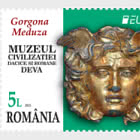Minerals
On the occasion of the celebration of 100 years since the foundation of the Geological Institute of Romania, Romfilatelia, the company specialized in issuing and trading Romania postage stamps, introduces into circulation the postage stamp issue Minerals.
The mineral is a solid body with a definite chemical composition which can be found in nature in crystalline or amorphous form. Minerals form the rocks and ores, being represented by various chemical combinations and, rarely, by native elements. Over 4000 minerals are known, among which silicates represent around 34%, oxides and hydroxides approx. 25%, and suphides approx. 20%.
Presented on the postage stamps of the issue are the following minerals: agate, amethyst, blende, quartz, fluorite and stibnite.
Fluorite (CaF2) – fluorum in Latin. The crystallization system is cubical. Very seldom it can be colourless or coloured in honey yelloy, green, violet, blue, sometimes having one colour inside and another colour outside. It has a glassy glare. It is thermoluminescent and fluorescent. It is used as a fusing agent in metallurgy, in optics, in the chemical industry, as well as in the ceramics industry. In Romania, it can be found in Baia Mare, Macin, Tulghes, Brad.
It is illustrated on the postage stamp with the face value of Lei 0.30.
Quartz (SiO2) – The crystallization system is trigonal and has a great number of various forms. By its aspect and, particularly, by its structure and colour, we have phanerocrystalline varieties: (rock crystal – colourless, transparent, citrine – yellowish, morion – dark smoky colour, amethyst – violet, tiger eye – brownish yellow); cryptocrystalline (chalcedonia – variety of fibrous, superfine quartz, with various colours: onyx, sardonyx) and amorphous (opal – hydrated form of silica). Besides the feldspars, it is the most wide-spread mineral in the earth shell. It is used as a semiprecious stone, in optics, computers, glass and abrasives industry.
It is illustrated on the postage stamp with the face value of Lei 0.50.
Agate (SiO2), whose name comes from the river Achates of Sicily, is a variety of chalcedony with regular concentric areas, nicely coloured in various nuances. It is used as a semiprecious stone. In Romania, it can be found in Maramures and Apuseni Mountains.
It is illustrated on the postage stamp with the face value of Lei 1.00.
Blende (ZnS) or Sphalerite (sfaleros in Greek) is a natural zinc sulphide of yellow, green, red, brown or black colour. The crystallization system is cubical. It is used in the metallurgic industry. Deposits in Romania: Baia Mare, Apuseni Mountains, Moldova Noua.
It is illustrated on the postage stamp with the face value of Lei 1.20.
Amethyst (SiO2), amethystos in Greek, is a variety quartz, coloured in violent, with bi-pyramidal forms, without prism sides or prismatic crystals, ending directly with the rhombohedron. It is used as a semiprecious stone. In our country, it can be found in Maramures.
It is illustrated on the postage stamp with the face value of Lei 1.50.
Stibnite (Sb2S3) or Antimonite (stibium in Latin), has a rhombic crystallization system. Crystals are always prismatic and oblong, usually with vertical striae. Often they have the form of radially arranged sheaves. The colour is blueish gray or even grayish black, with metallic gloss. It is the most important, out of which the antimony is extracted, which is used for antifriction alloys, printing, in the rubber and glass industry, in pharmaceutical preparations, metal fitting products. In Romania, it can be found in Baia Mare.
It is illustrated on the postage stamp with the face value of Lei 2.20.
Romania - Recommended stamp issues
WOPA+ recommended stamp issues
| Avatar - Fire and Ash |
| Issued: 03.12.2025 |
| ›New Zealand |
| 50th Anniversary of the Founding of the 24th November Bar Scout |
| Issued: 24.11.2025 |
| ›Montenegro |
| Krisjanis Valdemars |
| Issued: 02.12.2025 |
| ›Latvia |
| Sign Language - Good |
| Issued: 02.12.2025 |
| ›Bosnia and Herzegovina - Republic of Srpska |
| In Memory of the Fallen and Murdered on October 7, 2023 |
| Issued: 08.10.2025 |
| ›Israel |
| Annual Collection Folder (New York) |
| Issued: 05.12.2025 |
| ›United Nations |
| Year Set |
| Issued: 24.11.2025 |
| ›Isle of Man |
| Shipping in the 17th and 18th Centuries - Peat Shipping |
| Issued: 05.12.2025 |
| ›Netherlands |












































